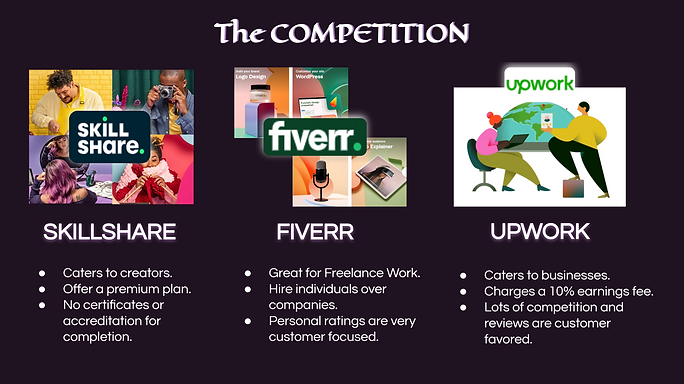
Project Overview
The Problem
On social platforms, users often feel unnoticed and struggle to showcase their creations and abilities. There is a need for a more direct platform that caters to creators and helps them stand out.
The Solution
Our solution is Talent Chrome, a platform for creators that offers features to increase their visibility and showcase their work. It also curates content and gives personalized recommendations to help creators reach their audience and employers. It aims to create a supportive and rewarding space for user-generated content.
My Role
I collaborated with another UX/UI designer on the research, definition, and ideation phases.
My focuses' were on writing interview script, creating personas, taking interviews, creating mood board, working on style guide, sketching wireframes and working on high fidelity prototype.
Tools
-
Figma
-
Miro
-
Adobe Photoshop
-
Canva
-
Adobe Photoshop
-
Google Slide

User Research
Proto Persona

User Interviews
Interview
-
6 creators
-
15 questions
Focus
-
Personal abilities
-
Current promotion methods
-
Preferred features
-
Desired user experience.
One of the questions which open the floor for our users to give us their opinion
-
What type of platform design do you want to see constructed that caters to giving creators like you an opportunity to show your hobby/talent/skill?

Survey Findings

Affinity Diagram

Feature Prioritization

Value Proposition

User Persona

Define
User Insight & Problem Statment
User Insight
In today's digital age, users need a platform that focuses on them in these overcrowded social media platforms where most get lost.
Problem Statement
Talent Chrome provides needed features such as enhanced visibility, curated sections, and personalized recommendations for users to showcase their talents.
User Journey & Story Board

Mood Board

Ideate
User Flow

Competitor Analysis

Style Guide

Prototype
Low Fi Wire Frame Sketches

HiFi Wire Frame Prototype

Final Thoughts
-
User testing allowed us to gain valuable insights about this development stage of the UX process.
-
We wanted a user centric design so we prioritized iterations based on negative feedback about the user experience, navigation, and page layouts.
-
Most useful feedback was focused on the Job page. Users asked for a lot of minimizing of design and categories and creating more inclusive filters.
-
AI will be considered as a future addition to help with navigation as well.
